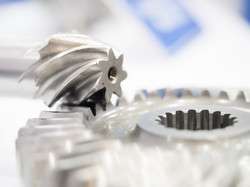Lightweight metal component processing offers competitive advantages

Lightweight components offer the aerospace and automotive industries the means to reduce energy consumption and emissions through the development of lighter vehicles, and provide other industrial sectors with flexible materials to develop new innovative tools. Manufacturing such high quality lightweight components however has consistently been a challenge; vibration and pressure during the milling process often means that manual labour is required to finish off production, thus ramping up costs.
The EU-funded DYNAMILL project, completed in October 2015, therefore sought to develop a cost effective and safe means of mass producing lightweight thin-walled parts ideal for sectors with good market growth potential such as transport, power generation and medical technology.
The end result of the three year project is a new technology platform that offers complete process planning, new adaptive clamping devices and improved cutting conditions. Process control is focused on high damping and low excitation of work piece vibrations, while planning is strongly supported by cutting edge software tools, including models for dynamic simulations of oscillation as well as computer-aided manufacturing.
Novel systems in the process include magnetic clamping, and a clamping device for manufacturing large turbines. Complex thin-walled structures have been combined with high strength materials, perfect for industries with very high safety and quality requirements such as aviation.
A total of five demonstration projects were carried out in order to show the potential benefits of the new DYNAMILL process on industry, and to highlight the broad-sweeping applicability of the platform. For example, the energy sector can benefit from better production of large and medium-sized turbine blades made of a steel alloy. Small turbine blades made of titanium can be efficiently produced for aircraft, while a satellite component, knee bone prosthetic and print media part were also successfully – and efficiently – produced.
The results of these five demonstration projects were then analysed. Improvements included a 30 % reduction in production time and costs, an 80 % increase in process stability, a 30 % reduction of power, compressed air and coolants and an impressive 70 % reduction of wasted raw materials during set-up. The cost-efficiency of the new process, once fully commercialised, will significantly enhance the competiveness of Europe's milling industry and have a knock-on effective across numerous industrial sectors.
Aerospace for example is one of the EU's key high-tech sectors, providing more than 500 000 jobs and generating a turnover of close to EUR 140 billion (2013). The EU is a world leader in the production of civil aircraft, including helicopters, aircraft engines, parts and components. EU-funded projects such as DYNAMILL will help ensure that the sector remains at the forefront of what is a competitive global industry.
The results of the DYNAMILL project were made possible thanks to the effective collaboration of two research institutes, four manufacturers of key technologies (CAM software, machine tools, clamping devices and tools) and four end users.
More information: For further information please visit the DYNAMILL project website: www.dynamill.eu/en/Dissemination.html
Provided by CORDIS




















